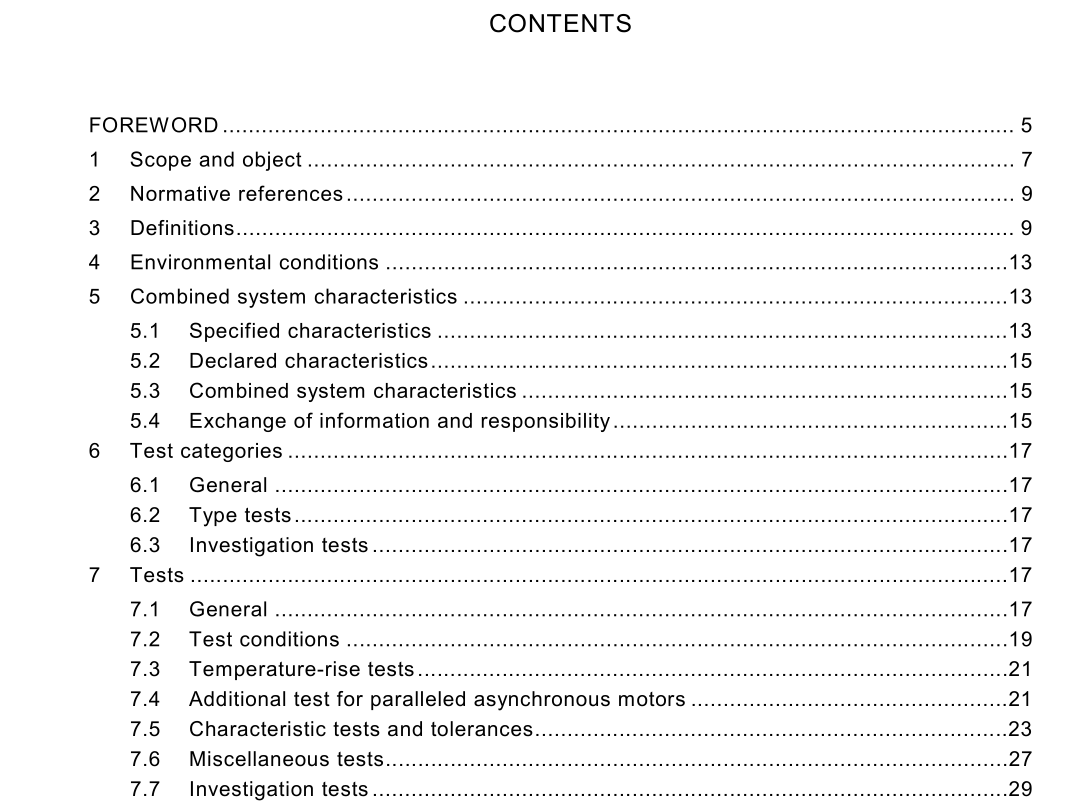IEC 61377-3 pdf download

IEC 61377-3 pdf download.Railway applications – Rolling stock
1 Scope and object
This International Standard applies to the combinations of motor(s), indirect convertors and their control system and its object is to specify: − the performance characteristics of electric drives consisting of a convertor, alternating current motors, and the related control system; − methods of verifying these performance characteristics by tests. Two categories of combined systems can be considered: a) Alternating current motors fed from a convertor without any control between the mechanical output (torque, speed) and the convertor itself (mostly auxiliary motors, for example cooling fan motors). The motor works exactly as if it were fed from a busbar (at variable frequency and voltage or not). b) Alternating current motor(s) (paralleled or not) with a control between the mechanical output and the inverter. The first category of systems is tested according to IEC 60349-2 and IEC 61287-1. This standard applies to the second category, mainly traction drives. IEC 60349-2 applies to convertor-fed alternating current motors, IEC 61287-1 to power electronic convertors; IEC 60571 applies to electronic equipment; this standard applies to the combination of motor(s), convertors, and their control system. As a consequence, IEC 60349-2 describes the tests to demonstrate the compliance of the motor to its specification, IEC 61287-1 does the same for the convertor. It is self-evident that some of the tests mentioned in this standard may in general replace the corresponding ones described in the above mentioned standards. An agreement should be reached between the parties to avoid the duplication of tests.A complete combined test is heavy, and often requires high power, which is not always available in workshop. An agreement between user and manufacturer may be reached to allow testing either in the workshop or on the vehicle. At the time of drafting of this standard, only the following combinations of motors and inverters have been used for traction applications, but it may also apply to other combinations which may be used in the future: − asynchronous motors fed by voltage stiff (voltage source) inverter; − asynchronous motors fed by current stiff (current source) inverter; − synchronous motors fed by current stiff (current source) inverter.The input of these inverters (see figure 2) can be a d.c. supply line or an intermediate d.c. link, which can be obtained from an a.c. line by means of a rectifier (2.2.1 of IEC 61287-1) or from a d.c. line by means of a chopper (2.2.2 of IEC 61287-1) or from autonomous supplies (such as on-board generators, accumulators or other electric energy sources) (1.1 of IEC 61287-1).
3 Definitions
For the definition of general terms used in this standard, reference should be made to IEC 60050(411), IEC 60050(551), IEC 60050(811), IEC 61287-1 and IEC 60349-2. For the purpose of this International Standard, the following definitions apply. 3.1 combined system unit consisting of the indirect convertor, the motor(s), their related control system, equivalent power cables connecting them, and an equivalent cooling system 3.2 user organization which orders the combined system. The user is normally an organisation which uses the vehicle or the equipment, unless the responsibility is delegated to a main contractor or consultant (see figure 1).3.5 manufacturer’s works location where tests are generally performed 3.6 duty statement of the load to which the combined system is subjected, including, if applicable, electric braking, no load, rest and de-energized periods, as well as their duration and sequence in time 3.7 duty cycle variation of load with time which may or may not be repeated, and in which the cycle time is too short for thermal equilibrium to be attained 3.8 load profile (see also IEC 61287-1) mainly the convertor output current and other relevant parameters, as a function of time, to which the combined system is subject, to obtain the duty defined in 3.6 NOTE The load profile can correspond to the effective duty, or be a theoretical cycle. 3.9 rating of a combined system combination of simultaneous values of electrical and mechanical quantities, with their duration and sequence, assigned to the combined system by the manufacturer









